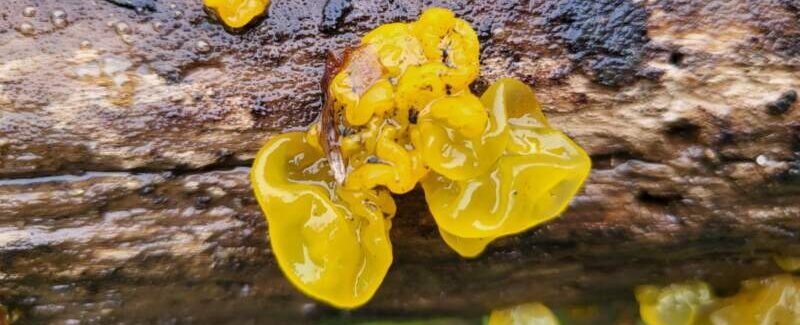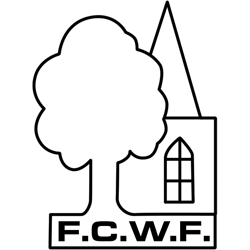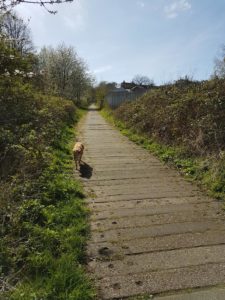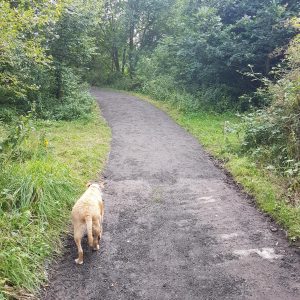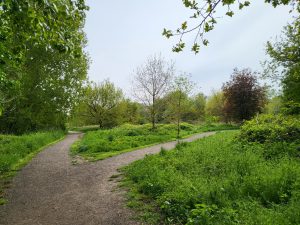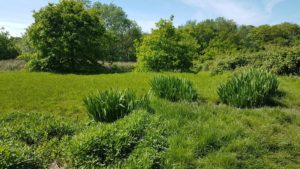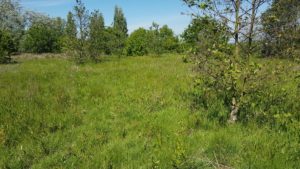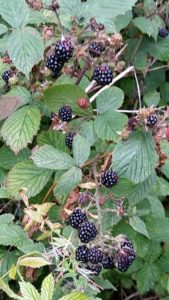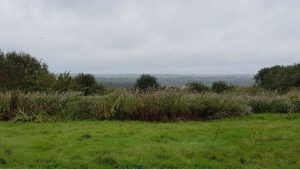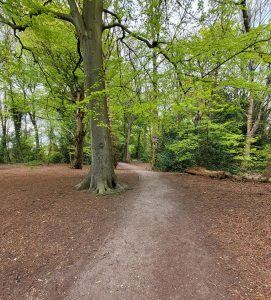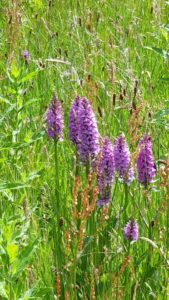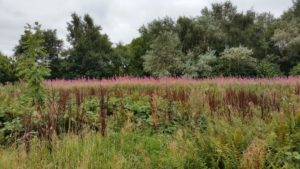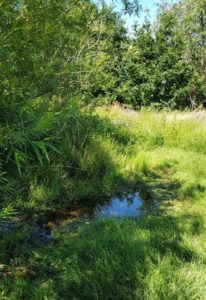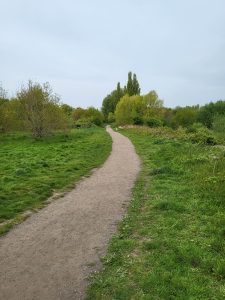The Top Field, through the Willow Plantation, and The Beech Woods.
45 Minutes Approximately from the Childwall Lane Entrance.
Not suitable for buggies or wheelchairs across the field due to the path there being soft and uneven.
During this walk, you will experience the vastly different environments of the woods and the fields, each encouraging its own particular flora and fauna.
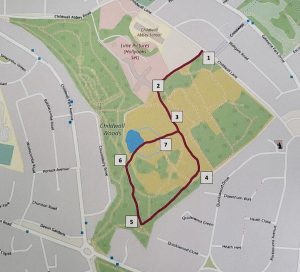
You will need strong shoes to walk on the field during the winter and some of the springtime depending on the weather.
1 The Concrete Path
The walk begins at the Childwall Lane Entrance to the Fields and begins with the walk up the concrete path.
If you are new to this entrance you may wonder what this path is doing here. It is made from concrete blocks and is the only one like it on the site. However, if you know the history of the site you will know that Childwall Fields used to be called Childwall Park until it was used as a landfill site in the1960s.
This path is a relic from the time when heavy lorries would travel up to the top to tip their load.
There is quite a slope here but is perfect for buggies and for burning off a few calories.
Wheelchair users would find the entrance a problem as it is not very wide.
2 The Top Field.
The concrete path takes you to a newly renovated path that bends to take you onto the top field.
The path branches here but keep to your left and take the path across the edge of the field.
The fields have been used for many things through the years. The gentle grassy slope of Childwall Park, became the golf course when leased to Childwall Golf Club, and it was used for growing vegetables during WW2. Then, sadly, in the 60s, as a landfill site.
However, that changed in the 70s when the site was landscaped and capped with clay before being covered in topsoil. The aim was to provide the college which had replaced Childwall Hall, with 3 sports fields, one for football, one for rugby, and one for cricket, but the story goes that they were always too wet and couldn’t be used. The college was sold to Lime Pictures and the fields were abandoned.
Then nature stepped in to take back the area and did a brilliant job of disguising what lies below.
After a programme of habitat improvement in 2021/22 the top field has lost most of its bramble and nettle and was planted with wildflowers to attract many creatures to it including butterflies and birds.
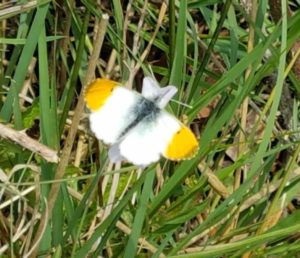
A male Orange-tip Butterfly, one of the earliest butterflies to arrive on the fields.
This is the perfect place to see some of the birds that live on the site.
Our bird page will help you identify a few.
Although brambles can be a nuisance to walkers, they redeem themselves in the autumn with their gift of blackberries, and there are plenty here from July onwards.
They are also an essential habitat for birds, butterflies and small rodents who use them as food and shelter.
Look to your left.
3 The Overlook
At this point, you will be rewarded with a panoramic view across Lancashire with some distinctive landmarks visible in the distance.
A pair of binoculars is always useful here.
4. The Willow Plantation
Follow the path around the edge of the top field and you will find yourself entering the ‘Willow Plantation’.
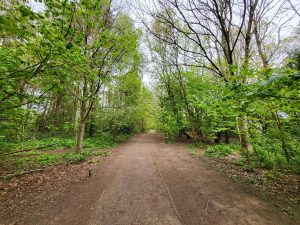
The path through the willow plantation
Here the path is edged on both sides by trees, mostly Willow, that were planted sometime after the field was reclaimed. In summer it is shady and cool but in spring and in autumn it holds a few surprises.
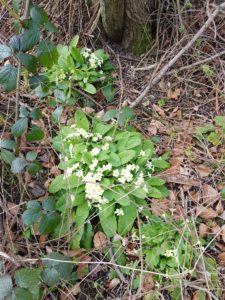
Primroses in Spring
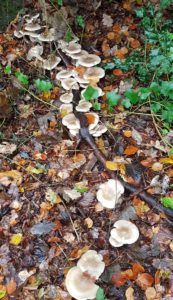 Clouded Funnel (Clitocybe Nebularis) is a forest floor mushroom and seems to love our wooded areas in autumn, especially the Willow Plantation.
Clouded Funnel (Clitocybe Nebularis) is a forest floor mushroom and seems to love our wooded areas in autumn, especially the Willow Plantation.
5 The Beech Woods.
The path through the plantation takes the walker into the southern part of the beech woods. Here it joins the main path.
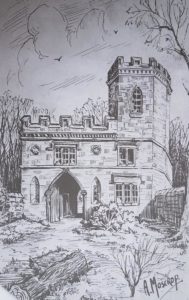
The second Lodge near to Woolton Road Entrance.
Straight ahead at this junction is the site of the second Lodge that can be seen on maps as far back as 1849. There is little to show of that building these days except for a very low wall in the ground and an artist’s impression of what the Lodge looked like a hundred years ago. Kindly donated by Ray Lowe whose father Billy was born in the lodge.
Turn right onto the main path and follow it through the Beech Woods towards the field.
After a short walk, you will see a path on your right which will take you across the field and back to the path you came on. Turn right here and walk by the dipping pond on your left.
6 The Dipping Pond and Wetland.
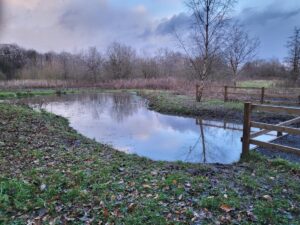
The pond on your left was created in February 2022 to provide the site with standing water throughout the year. Although there were scrapes around the field there has always been a shortage of water that would remain long enough for small amphibians to develop.
It was hoped that by excavating in an already wet area, another habitat would be created for water-loving invertebrates, dragonflies, birds, plants, etc and that seems to have been the case.
Still young, this pond has become a wonderful habitat for many creatures that cannot survive on the site without standing water.
The first pond of two, this pond has a dipping platform for children to engage in pond dipping when accompanied by a responsible adult.
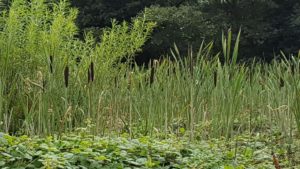
Bullrushes in September
At the far end of the dipping pond, you can see bullrushes in various stages of development according to the time of year. Autumn is the best time to see them.
These bullrushes make a brilliant screen for the second pond, the ‘Wildlife Pond’ which requires a bit of privacy, hidden away behind them.
After the pond, the path is just a track and becomes quite marshy and rough according to the season, so be aware, that it is not suitable for buggies or wheelchairs.
The top field is a wonderful place to see wildflowers in the spring and summer. One of them is the Marsh Orchid, arguably one of the most beautiful flowers of all. It can be seen all over the wetter areas during May and June. A sight worth seeing.
On the right side of the top field in summer you will see a line of pink dividing the field from the woods. Rosebay Willowherb puts on this show each year, to delight the observant walker.
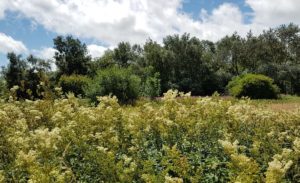
The top field with some of its summer flowers.
Irises brighten up this site in summer along with Michaelmas Daisies and many other beautiful wildflowers, many of them planted by Friends of Childwall Woods and Fields to bring in more butterflies and bees, at the bottom rung of the food chain.
7. The old scrape
Halfway along the path on the top field, you will come to an old scrape with a willow tree in it and yellow flag irises on one side. This is often dries up after spring.
Here is a rare picture of the scrape in June with water.
The wet area is a great attraction for birds and it is common to see flocks of 20 Magpies in and around this feature.
Having walked down the centre of the field rejoin the main path at the overlook and turn sharp left.
This will take you back to the concrete path once more.
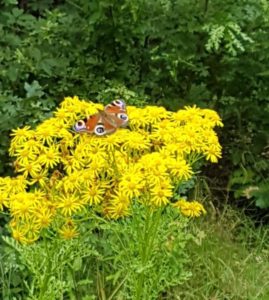
A Peacock Butterfly
As you walk back with the Poplar Trees on your right, look to your left. In winter there’s is little here but in summer Ragwort appears and all that it attracts.
This plant is not well-loved by people but seems very popular with butterflies, bees and caterpillars.
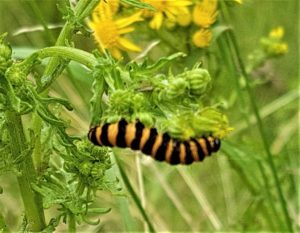
The caterpillar of the Cinnabar Moth. Another resident of Childwall Fields
If you walk past this site in summer be sure to stop and take a closer look. You may be surprised by what you see there.
As you walk back down to the exit on Childwall Lane you might just reflect on what a lovely walk this landfill site has turned into.
B Cameron
Photographs are the author’s own unless otherwise stated.
